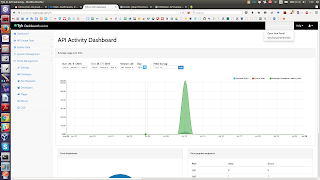There was this long running bug that is hitting us from setting up the Tyk portal. The issue was with Tyk not allowing custom domains from being set up as portal. While the settings as advised in Tyk mention the dashboard and portal port as 3000, ideally it should be set as 80 to get the portal configured seamlessly. I learned it hard-way after so many attempts on getting this done on port 3000.
 |
| Setting up Portal Domain |
127.0.0.1 dashboard.tyk-local.com
127.0.0.1 portal.tyk-local.com
Most probably Apache2 or some other web server would already be listening on the port 80. Make sure to stop it to release the port.
Stop Apache2 Web Server
/etc/init.d/apache2 stop
Configure Tyk Gateway
sudo /opt/tyk-gateway/install/setup.sh --dashboard=http://dashboard.tyk-local.com --listenport=8080 --redishost=localhost --redisport=6379 --domain=""
Configure Tyk Dashboard
sudo /opt/tyk-dashboard/install/setup.sh --listenport=80 --redishost=localhost --redisport=6379 --mongo=mongodb://127.0.0.1/tyk_analytics --tyk_api_hostname=127.0.0.1 --tyk_node_hostname=http://127.0.0.1 --tyk_node_port=8080 --portal_root=/portal --domain="dashboard.tyk-local.com"
Configure Tyk Pump
sudo /opt/tyk-pump/install/setup.sh --redishost=localhost --redisport=6379 --mongo=mongodb://127.0.0.1/tyk_analytics
Initial start to set up the Tyk license
sudo service tyk-pump start
sudo service tyk-dashboard start
Access http://dashboard.tyk-local.com/ and add the license in the prompt.
Restart the Tyk Dashboard and start the Tyk Gateway
sudo service tyk-dashboard restart
sudo service tyk-gateway start
Fix the Tyk bootstrap script to listen at port 80
gedit /opt/tyk-dashboard/install/bootstrap.sh and remove :3000 from all the references, since we are going to use the default port 80, instead of port 3000 as the dashboard port.
#!/bin/bash
# Usage ./bootstrap.sh DASHBOARD_HOSTNAME
LOCALIP=$1
RANDOM_USER=$(env LC_CTYPE=C tr -dc "a-z0-9" < /dev/urandom | head -c 10)
PASS="test123"
echo "Creating Organisation"
ORGDATA=$(curl --silent --header "admin-auth: 12345" --header "Content-Type:application/json" --data '{"owner_name": "Default Org.","owner_slug": "default", "cname_enabled": true, "cname": ""}' http://$LOCALIP/admin/organisations 2>&1)
#echo $ORGDATA
ORGID=$(echo $ORGDATA | python -c 'import json,sys;obj=json.load(sys.stdin);print obj["Meta"]')
echo "ORGID: $ORGID"
echo "Adding new user"
USER_DATA=$(curl --silent --header "admin-auth: 12345" --header "Content-Type:application/json" --data '{"first_name": "John","last_name": "Smith","email_address": "'$RANDOM_USER'@default.com","password":"'$PASS'", "active": true,"org_id": "'$ORGID'"}' http://$LOCALIP/admin/users 2>&1)
#echo $USER_DATA
USER_CODE=$(echo $USER_DATA | python -c 'import json,sys;obj=json.load(sys.stdin);print obj["Message"]')
echo "USER AUTH: $USER_CODE"
USER_LIST=$(curl --silent --header "authorization: $USER_CODE" http://$LOCALIP/api/users 2>&1)
#echo $USER_LIST
USER_ID=$(echo $USER_LIST | python -c 'import json,sys;obj=json.load(sys.stdin);print obj["users"][0]["id"]')
echo "NEW ID: $USER_ID"
echo "Setting password"
OK=$(curl --silent --header "authorization: $USER_CODE" --header "Content-Type:application/json" http://$LOCALIP/api/users/$USER_ID/actions/reset --data '{"new_password":"'$PASS'"}')
echo ""
echo "DONE"
echo "===="
echo "Login at http://$LOCALIP/"
echo "User: $RANDOM_USER@default.com"
echo "Pass: $PASS"
echo ""
Save and exit the bootstrap script and execute it.
sudo /opt/tyk-dashboard/install/bootstrap.sh dashboard.tyk-local.com
root@llovizna:/home/pradeeban# sudo /opt/tyk-dashboard/install/bootstrap.sh dashboard.tyk-local.com
Creating Organisation
ORGID: 579794145ee8571e46000001
Adding new user
USER AUTH: 6936a780a8e448fd73e3d7ef64eb8059
NEW ID: 5797941458149ac06a14e801
Setting password
DONE
====
Login at http://dashboard.tyk-local.com/
User: c9og13fnc8@default.com
Pass: test123
 |
| Tyk Developer Portal |
Set Portal domain
portal.tyk-local.com
This would give a message, "CNAME updated"
Now if you access http://portal.tyk-local.com/portal/ it would says "Home page not found". This is expected as you have not set up the portal and the welcome page yet.
Follow the below document to get this set up.
Once you have set this up, your portal is ready for the developers to register, log in, and consumes the APIs defined in the API catalogue.









No comments:
Post a Comment
You are welcome to provide your opinions in the comments. Spam comments and comments with random links will be deleted.